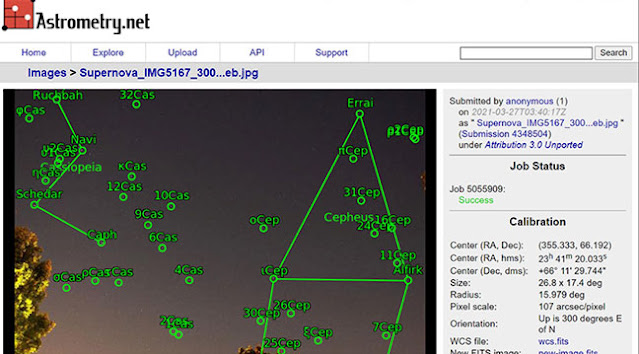Greetings from Palmia Observatory
Ok, so this week we are going to reveal the symmetry trick used in the last blog and then go on to pretend to look for the recently announced supernova and finish up with some great advice from Aunty Acid.
The trick used in the last three images of mirror imaging the book was just to place a mirror image copy of the front cover in place of the original book cover. So the images you saw always included the mirror image copy and so then in some instances of mirror imaging the whole scene the text looked right and other times looked backwards.
 |
| Original textbook (left) and mirror image cover sheet (Source: Palmia Observatory) |
Well, Doing Physics and Martinis in Palos Verdes, Dr. Ken, responded to the quiz saying he was too busy to work on it but suggested a great book, "Symmetry and the Beautiful Universe." Yes, it is a great book and I look forward to getting more into it. The book is mostly equation-less but nonetheless goes over a lot of the important theories of symmetry including discussion of Emmy Noether's theorem and much more. So check it out if you like looking at symmetry. Thanks for that, Ken!
 |
| Symmetry and the Beautiful Universe (Source: L. Lederman and C. Hill) |
In other astronomical news, we received a note from Visionary Physicist, Dr. Don, about an Apple News article of March 20, alerting us about the bright new supernova in Cassiopeia. The nova was discovered by a Japanese amateur astronomer and images of the nova now show it to be at least magnitude 7.9. The article showed the location just off of Cassiopeia and listed the right ascension (RA) and declination (Dec) for those interested in a more precise location. Thanks for alerting us, Dr. Don!
 |
| Location and RA and Dec for recent supernova in Cassiopeia (Source: Apple News) |
OCA Dave Kodama also alerted us to this Sky and Telescope magazine article about taking a look for the supernova that some people would be able to see in their backyards with just binoculars. Thanks for the alert also, Dave!
 |
| Notice of the location of the supernova in Cassiopeia (Source: Sky and Telescope) |
Ok, so, the nova is going to be pretty dim and hard to see in city lights viewing, but that minor issue didn't stop this lazy astronomer from just going outside and pointing the camera in the right position. In this DSLR, 37mm, 8 second exposure you can see how bright the background lights are and yet we can make out the lower part of the "W" in Cassiopeia. So, if we are lucky the supernova should be in the image, even though it might be quite dim and hard to tell it from other stars in the background.
 |
| Looking for the supernova in Cassiopeia, DSLR, 8 seconds, 37mm (Source: Palmia Observatory) |
This next image is just a cropped version of the image shown above and narrows in on the supposed location of the supernova.
 |
| Cropped version of DSLR image with supposed supernova (Source: Palmia Observatory) |
So, with the relative position of Cassiopeia in the photo, it seemed that we should have also been in the right location to see the nova if it were visible in the city lights viewing. To make sure we were looking in the right location, the image was submitted to Astrometry.net to verify the actual sky location. The center of the photo field of view has RA = 23 41 20 and Dec = 66 11 29 and covers an area of 28 x 17 degrees. Yep, the nova is probably down there near 4 Cas.
 |
| Astrometry,net indicates the supernova location is in the cropped image (Source: Palmia Observatory) |
But, I can't really tell which of various specks of light are the supernova and which are just background stars. To see if the background stars can be identified and separated from the possible supernova, another tool, Megastar 5, was used to try to zero in on the possible background stars. In this screenshot you can see the camera field of view outlined as the yellow rectangle. The location of the supernova is pinpointed to be within the red circle. We could continue with Megastar 5 or switch to Maxim DL and do some photometry and try to find the nova. But, I'm tired out now and elected to just say that at least we pretended to look for the supernova.
 |
| Megastar 5 screenshot with camera frame (yellow) and supernova location (red) Source: Palmia Observatory) |
Finally, just in time for our pretending to look for the supernova, the cartoon of the day from Aunty Acid identifies a topic of particular concern to this Lazy Astronomer Wannabe. I often describe myself as a lazy astronomer because I go out observing with just my flimsy camera tripod, rather than my very heavy tripod or go to scope tripod, because I am too lazy to do the extra work. I also choose to just go outside or down the street to make some observations rather than drive for a couple of hours to a dark sky site like Anza or Borrego Springs or wherever. But, with Aunty Acid's renaming of the condition, I like much better to the Astronomer Wannabe With Selective Participation, in lieu of the lazy astronomer. Hooray and thank you Aunty Acid!
 |
| Hmm, maybe the lazy astronomer is just selectively participating? (Source: Aunty Acid, 3/26/21) |
Until next time, here from our burrow, stay safe, as we recover more of our freedom,

No comments:
Post a Comment